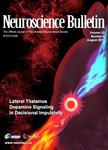Neurocognitive Graphs of First-Episode Schizophrenia and Major Depression Based on Cognitive Features
Neurocognitive Graphs of First-Episode Schizophrenia and Major Depression Based on Cognitive Features作者机构:Mental Health Centre West China Hospital Sichuan University Huaxi Brain Research Centre West China Hospital Sichuan University Department of Computing Science University of Alberta Language and Genetics Department Max Planck Institute for Psycholinguistics Huaxi Biobank West China Hospital Sichuan University Department of Psychiatry University of Alberta
出 版 物:《Neuroscience Bulletin》 (神经科学通报(英文版))
年 卷 期:2018年第34卷第2期
页 面:312-320页
核心收录:
学科分类:0710[理学-生物学] 1002[医学-临床医学] 1001[医学-基础医学(可授医学、理学学位)] 100205[医学-精神病与精神卫生学] 10[医学]
基 金:funded by National Nature Science Foundation of China Key Projects(81130024,91332205,and 81630030) the National Key Technology R&D Program of the Ministry of Science and Technology of China(2016YFC0904300) the National Natural Science Foundation of China/Research Grants Council of Hong Kong Joint Research Scheme(8141101084) the Natural Science Foundation of China(8157051859) the Sichuan Science&Technology Department(2015JY0173) the Canadian Institutes of Health Research,Alberta Innovates:Centre for Machine Learning the Canadian Depression Research&Intervention Network
主 题:Schizophrenia Major depressive disorder Neurocognition Neurocognitive graph Graphical LASSO
摘 要:Neurocognitive deficits are frequently observed in patients with schizophrenia and major depressive disorder(MDD). The relations between cognitive features may be represented by neurocognitive graphs based on cognitive features, modeled as Gaussian Markov random fields. However, it is unclear whether it is possible to differentiate between phenotypic patterns associated with the differential diagnosis of schizophrenia and depression using this neurocognitive graph approach. In this study, we enrolled 215 first-episode patients with schizophrenia(FES), 125 with MDD, and 237 demographically-matched healthy controls(HCs). The cognitive performance of all participants was evaluated using a battery of neurocognitive tests. The graphical LASSO model was trained with aone-vs-one scenario to learn the conditional independent structure of neurocognitive features of each group. Participants in the holdout dataset were classified into different groups with the highest likelihood. A partial correlation matrix was transformed from the graphical model to further explore the neurocognitive graph for each group. The classification approach identified the diagnostic class for individuals with an average accuracy of 73.41% for FES vs HC, 67.07% for MDD vs HC, and 59.48% for FES vs MDD. Both of the neurocognitive graphs for FES and MDD had more connections and higher node centrality than those for HC. The neurocognitive graph for FES was less sparse and had more connections than that for ***, neurocognitive graphs based on cognitive features are promising for describing endophenotypes that may discriminate schizophrenia from depression.



